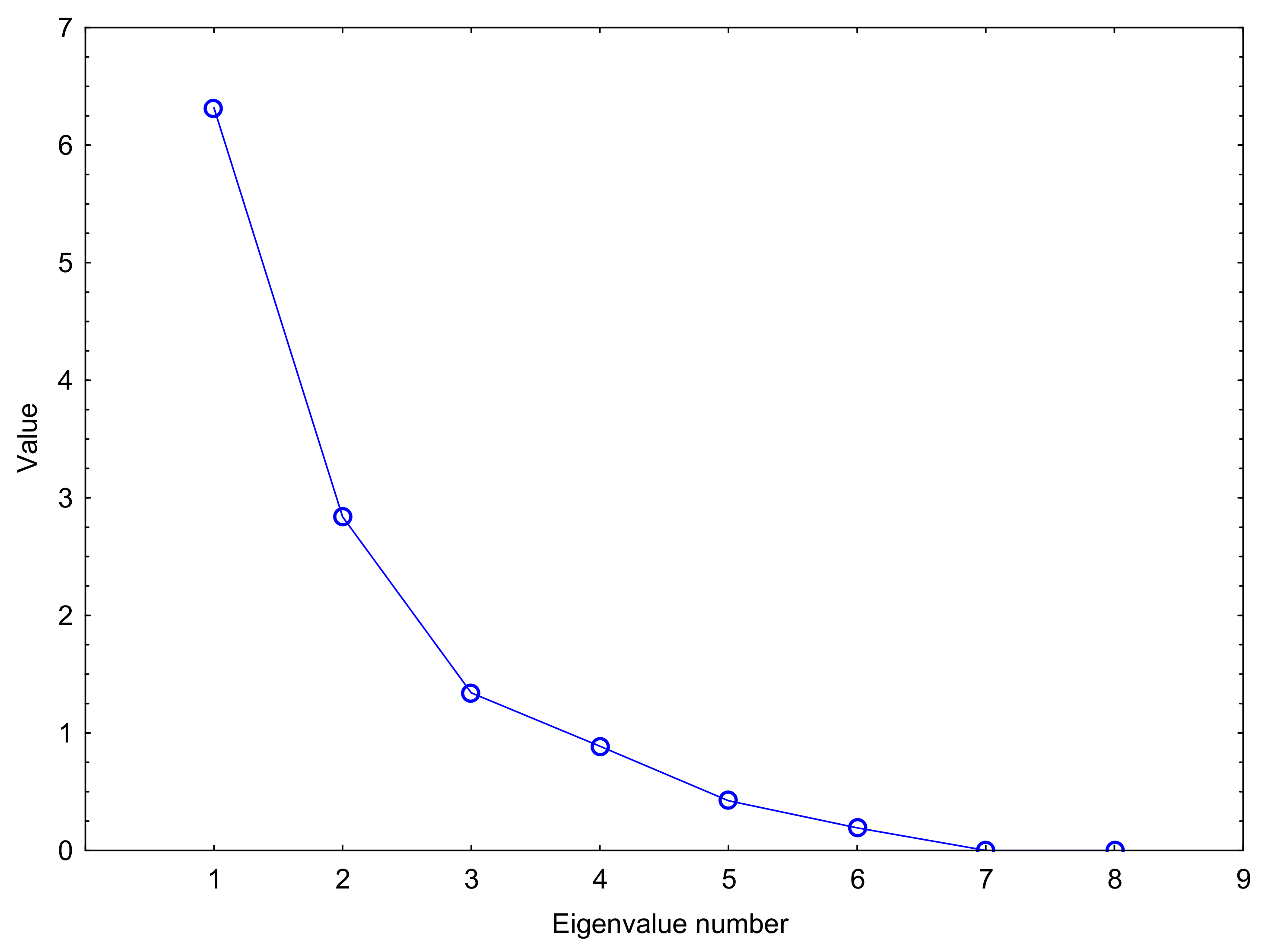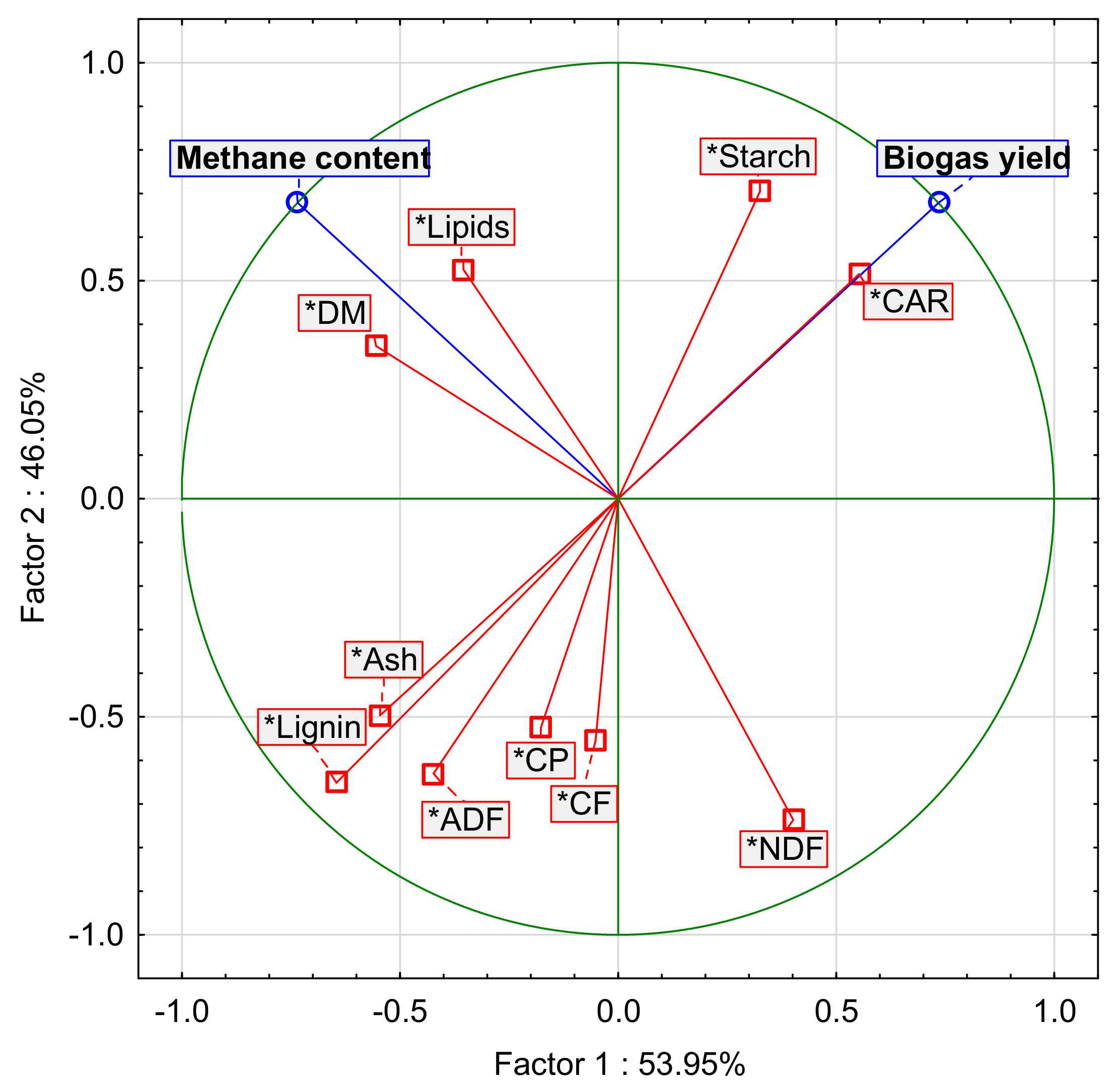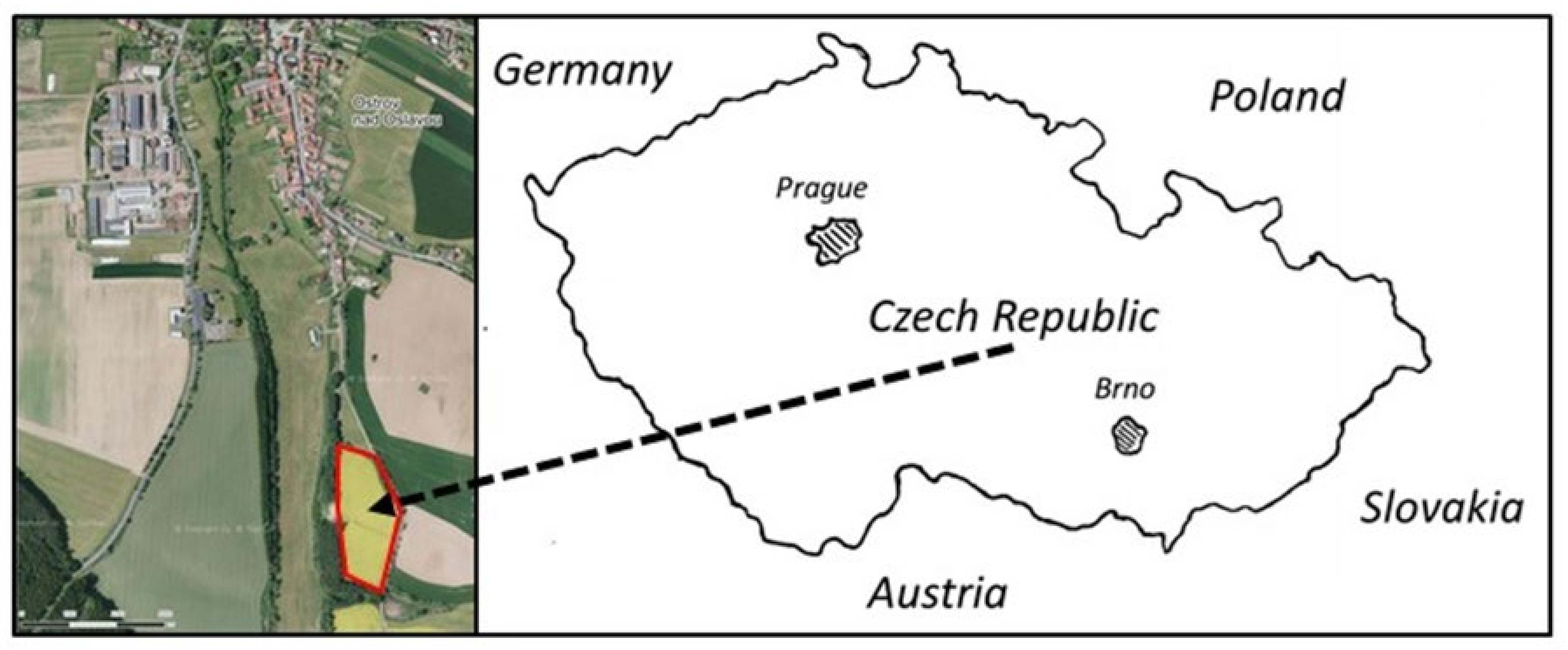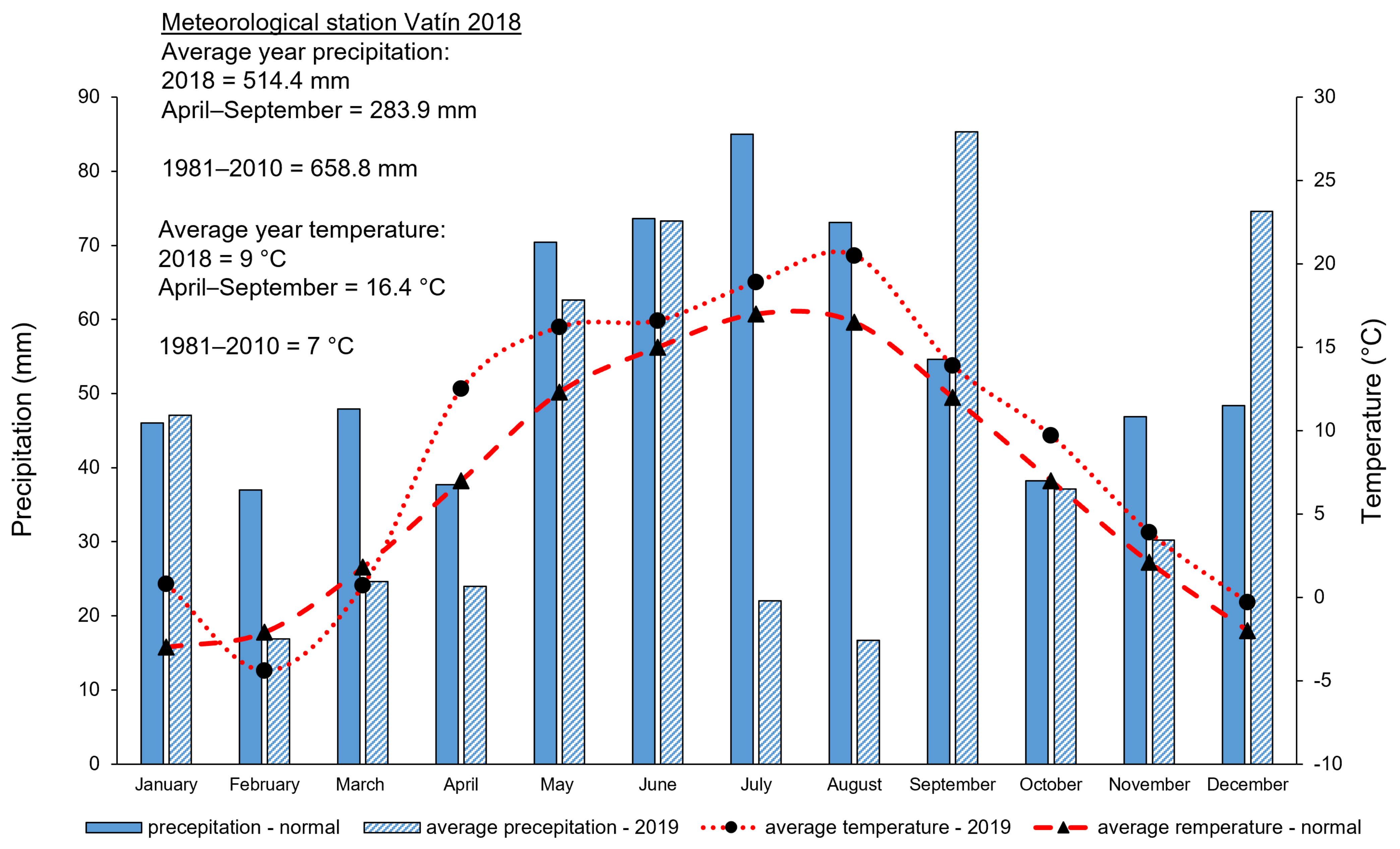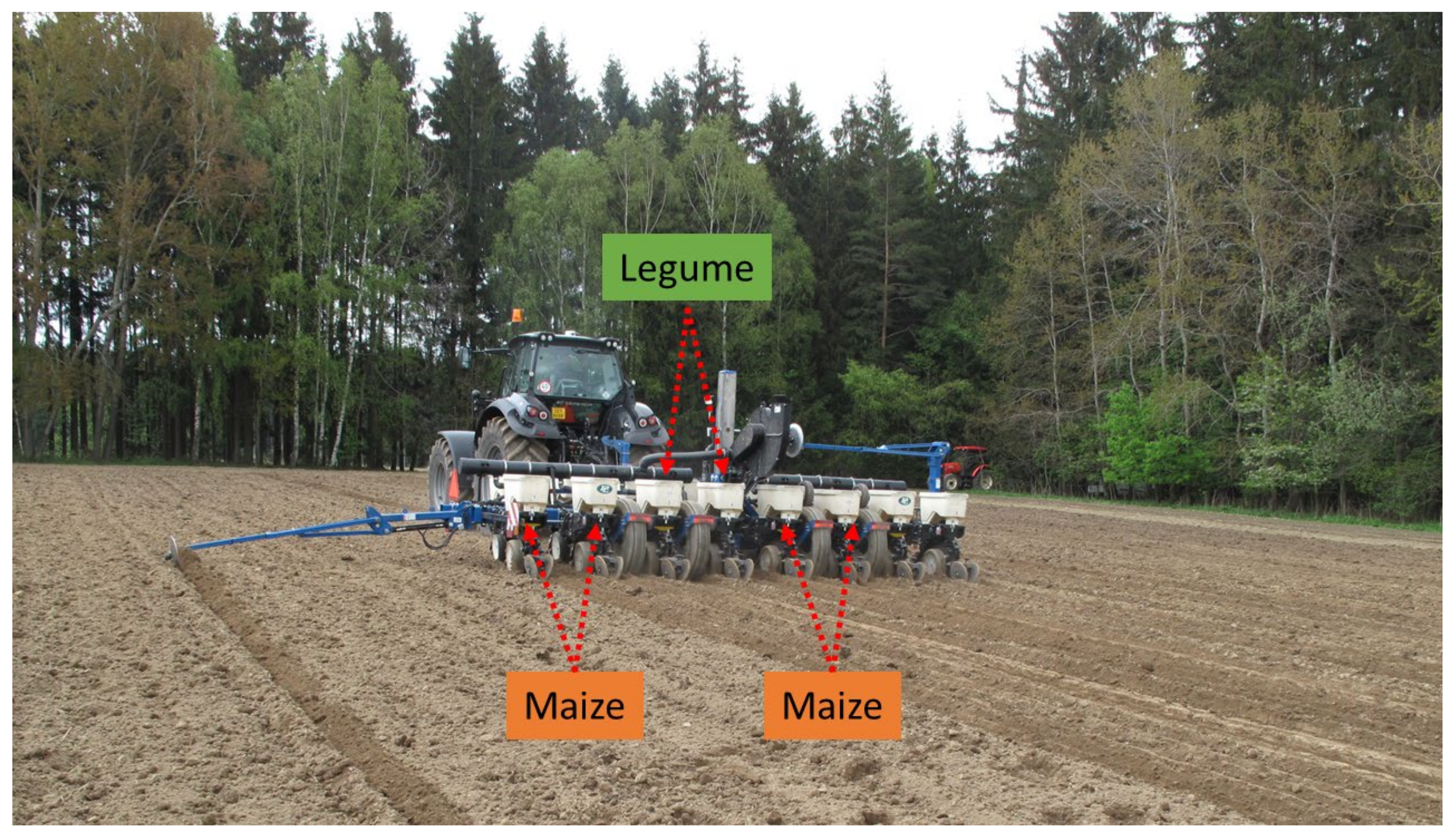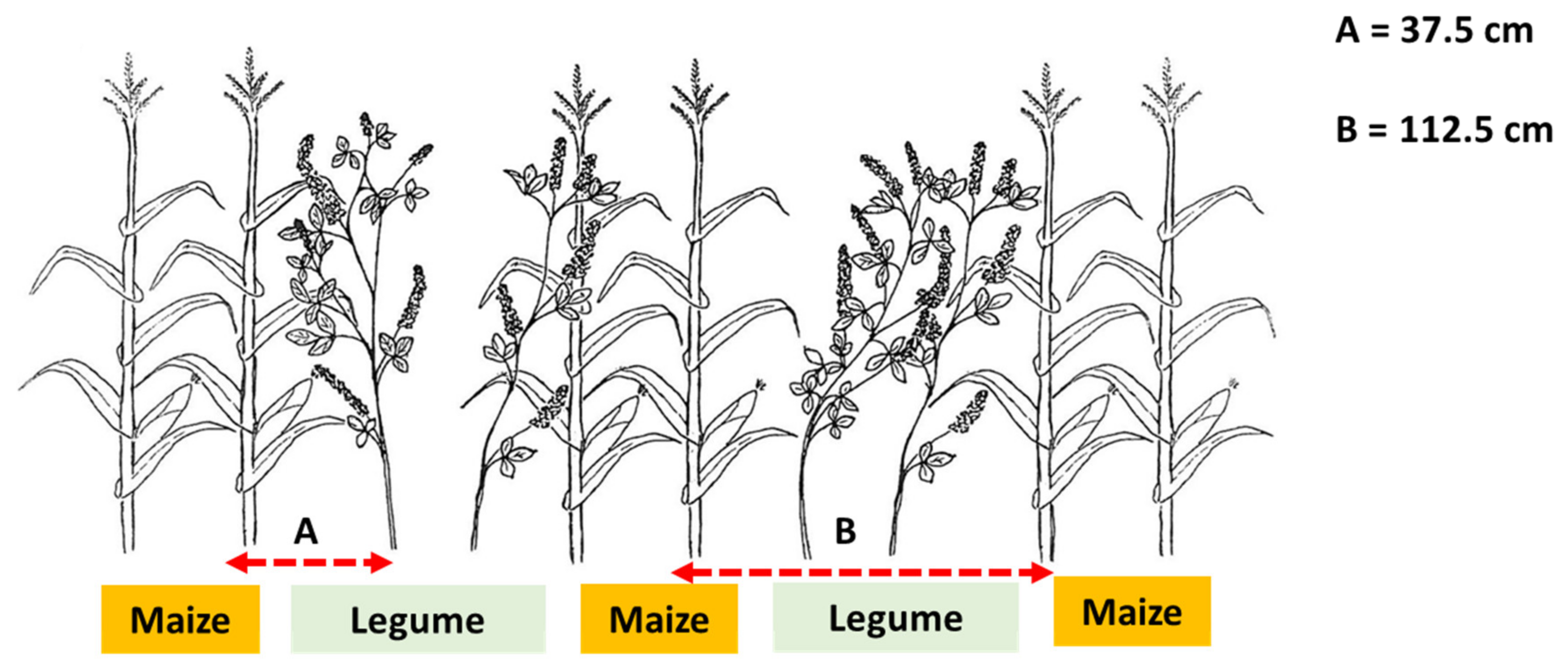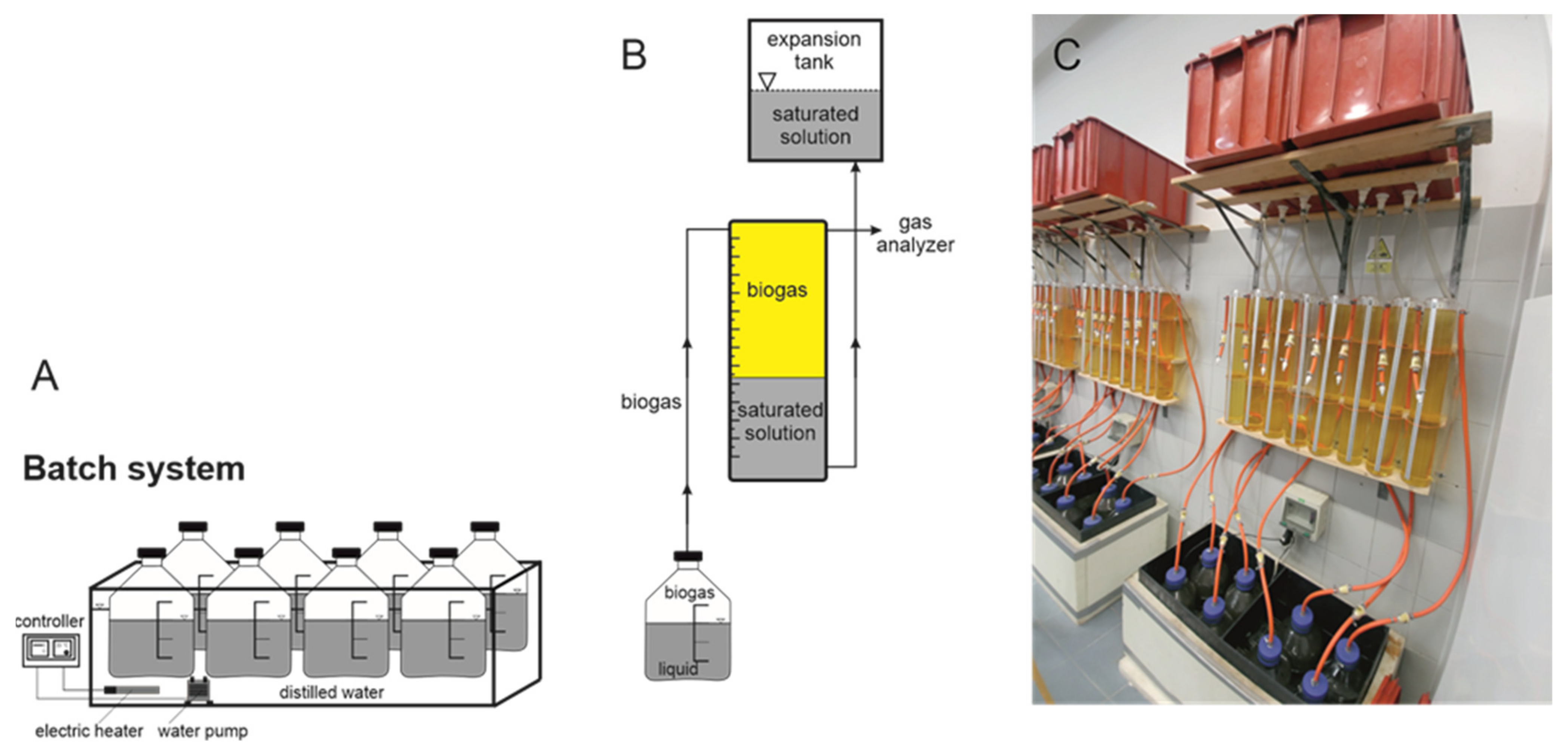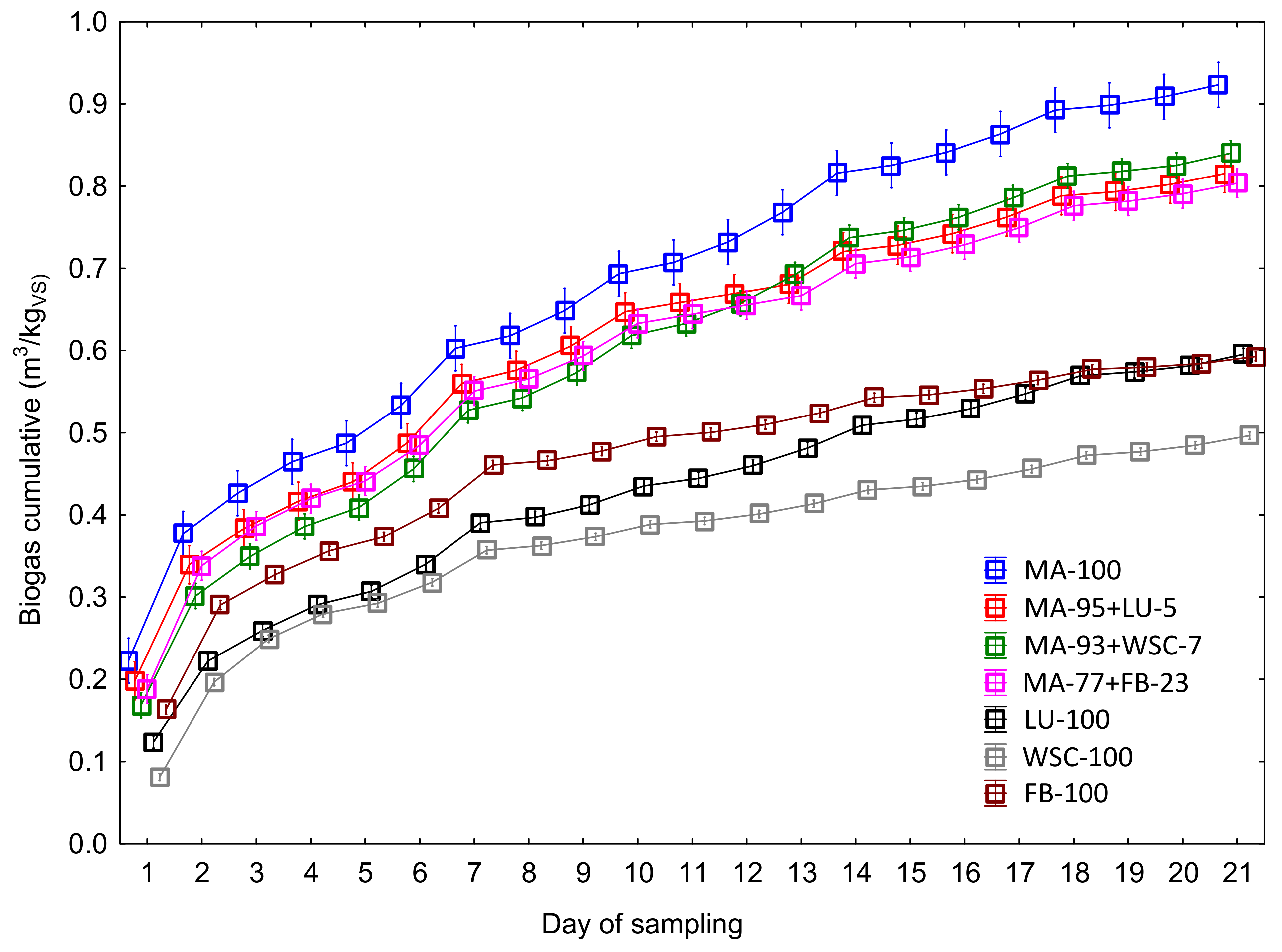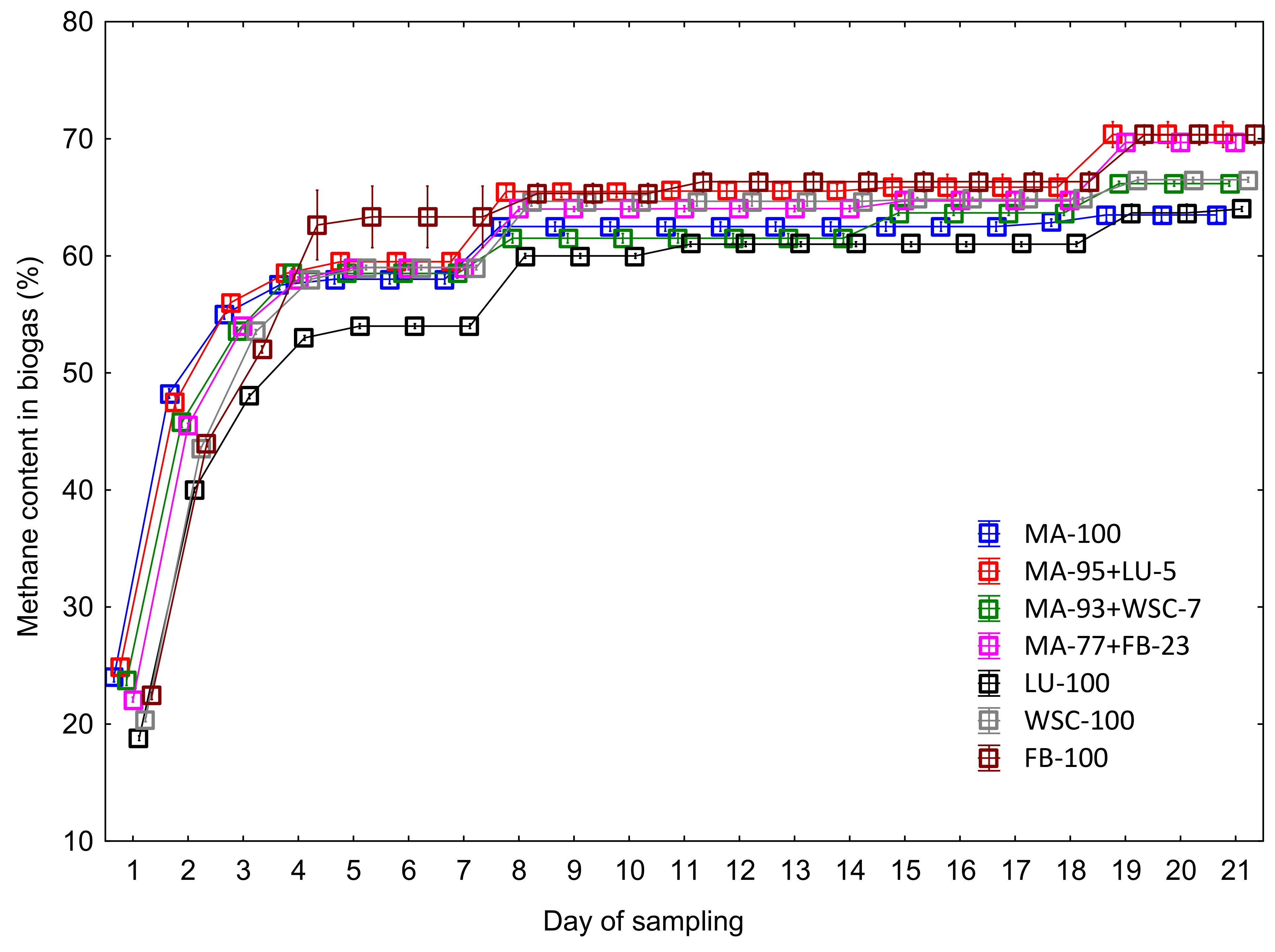3.1. Biomass Yield from the Mixed Culture
Yields (t/ha) were evaluated from four variants: MA-100, MA-95+LU-5, MA-93+WSC-7, and MA-77+FB-23. Fresh matter (FM) and dry matter (DM) yields achieved are presented in
Table 7 and
Table 8. In the case of variants with mixed cultures (MA-95+LU-5, MA-93+WSC-7, and MA-77+FB-23), both total yields and yields of individual crops are presented.
The highest average yield of fresh matter was achieved with the mixed culture MA-77+FB-23 (61.88 t/ha). The lowest average FM yield was achieved with MA-95+LU-5 (58.12 t/ha). However, there were no statistically significant differences between the individual variants. As to the relative difference, variant MA-77+FB-23 achieved a yield that was only 1% higher than that of control variant MA-100. The variant with the lowest yield reached only 95% of average yield.
Values of dry matter, DM (%), at harvest ranged from 26.9 (MA-100; control) to 28.0 (MA-93+WSC-7). The highest average yield of DM (t/ha) was reached with the mixed culture MA-93+WSC-7 (16.82 t/ha), and the lowest average yield of DM was reached with the mixed culture MA-95+LU-5 (15.78 t/ha). This was the only variant that exhibited a yield lower than MA-100. There were, however, no statistically significant differences between the individual variants.
Comparing the measured values of FM and DM yield (
Table 7 and
Table 8) in terms of their statistical significance, we arrive at an opinion that the mixed culture had no demonstrable influence on the yield of biomass. Thus, the absence of significant differences between the individual variants indicates that incorporation of legume into one cultivation system with maize does not have to lead to a significantly reduced yield of biomass. A similar experiment with the mixed culture of maize and legume was conducted by Htet et al. [
41]. The authors tested a possibility of growing soy and maize but arrived at opposite results. They inform the yield of DM in maize to be 14.5 t/ha, while various variants of mixed cultures of maize with soy exhibited statistically significantly lower yields ranging from 12.1 to 13.2 t/ha. Thus, the cultivation of maize in the mixed culture was almost equally advantageous or even more advantageous than the cultivation of maize in the monoculture.
Table 7 shows that results between the individual variants were non-significant. Growing of more than one crop in a mixed culture may often bring higher yields (both environmental and economic) than growing these crops as monocultures [
42]. Essential benefits are, among other things, increased soil erosion protection, biological fixation of nitrogen in the soil, and support of microbial activity in the soil [
22,
24,
30,
43]. It should be mentioned, however, that these potential benefits differ in the types of mixed cultures, and may be accompanied with reduced biomass yield as compared with the pure culture of maize and hence also silage for the biogas plant. The drop of yield ranges most frequently from 5 to 10% [
29,
44,
45] and it is therefore necessary that the cultivation of a mixed culture is planned differently than the growing of a maize monoculture so that a possible yield decrease does not put the biogas plant operation into danger.
3.2. Qualitative Parameters of Silage
The following parameters were used to describe the quality of silage from individual variants: content of dry matter (DM), ash, neutral detergent fiber (NDF), acido-detergent fiber (ADF), crude fiber (CF), starch, sugars (CAR), proteins (CP), lignin, and lipids (
Table 9 and
Table 10). These parameters were determined at the end of the ensiling process, i.e., after the opening of silage containers, and their values were converted according to the content of DM.
The content of dry matter (DM) was the highest in the silage from variant MA-93+WSC-7 (29.43%) and the lowest in the silage from monocultures LU-100 (21.54%) and MA-100 (21.23%). According to McDonald et al. [
46], an optimum range for DM in maize silage ranges from 28% to 32%. This range was achieved only in the silage variants from mixed cultures MA-93+WSC-7 and MA-77+FB-23. The values indicate that the content of DM was the highest in variants containing WSC and FB: MA-93+WSC-7, MA-77+FB-23, WSC-100, and FB-100. The trend is also corroborated with the statistically significant differences between these two groups of variants. The presence of legume in the mixture with maize statistically significantly increased the content of DM. According to Nabel et al. [
15], the DM content in silage from maize biomass or other crops is affected both by environmental factors of the site and by the characteristic of grown crops and their varieties or hybrids. Maize has long been bred to produce biomass for silage used for energy purposes, feeding, and biogas production. Legumes were primarily bred in the past to produce food and feeds rich in proteins or fiber. Therefore, it is clear that before varieties will be bred for use in biogas plants, the crops will mainly exhibit qualitative indicators that will be worse than the specially bred maize varieties. An exception can be some legumes that naturally exhibit, for example, a reduced content of fiber [
5,
15].
Htet et al. [
41] arrived at similar conclusions in their experiments with the mixed culture of maize and soy: variants of silages from mixed cultures always exhibited DM contents higher than silage from a maize monoculture. According to Geren et al. [
47], silage from the mixed culture of maize with
Vigna unguiculata L. Walp. and
Phaseolus vulgaris L. recorded a higher DM yield than maize alone and increased DM content as compared with the maize monoculture.
The content of ash was high in monosubstrates LU-100, FB-100, and WSC-100. On the contrary, the fourth monosubstrate MA-100 exhibited the lowest ash content (4.90%). In mixed variants, the content of ash ranged from 5.68 to 6.28%. Differences in the content of ash were statistically significant between all variants. Contrariwise, Htet et al. [
41] inform that the highest content of ash (7.7%) was recorded in the maize monosubstrate as compared with the variants of the mixed culture or maize and soy (7.2–7.3).
The content of neutral detergent fiber (NDF) in % DM ranged on average from 61.57% (LU-100) to 50.07% (MA-77+FB-23). Statistically significant differences were found among all seven variants. A lower NDF content was recorded in variants including FB.
The measured content of NDF in the variant MA-100 was 58.11%. According to other authors, the content of NDF in the MA silage ranges from 38.6% [
23] to 55.3% [
48]. Htet et al. [
41] measured 40.1% in the maize monosubstrate. Kintl et al. [
23] reported the value of 48.67% for the content of NDF in the silage of white sweet clover while Titei [
49] reported 58.1%.
The content of acid detergent fiber (ADF) ranged on average from 27.68% (MA-100) to 47.97% (LU-100) and
the content of crude fiber (CF) ranged on average from 23.48% (MA-100) to 29.57% (LU-100). The contents of ADF and CF represent an important indicator of the degradability of biomass, which enters the process of fermentation [
43]. In maize or legumes, of importance is the amount of ears or beans, which contain a lower amount of lignin than the plant stalk [
49,
50,
51]. In the case of maize, the measured ADF and CF values correspond to generally known hybrids determined for use in the process of fermentation [
50,
52]. In the case of legumes, the availability of comparable data is worse as silages are not so often made from legumes. Kintl et al. [
23] inform that white sweet clover contained 31.62% ADF, while Titei [
49] reports 40.7%. Tambara et al. [
53] inform, for example, that silage prepared only from white clover contained 20.34% of ADF and silage made from red clover contained 25.81% of ADF. These values are 20% lower as compared with the results of our experiment. The authors maintain that the main influence on the content of ADF and other worse degradable substances was not only the crop species but also the method of the production of shreddings.
The content of starch was the highest in MA-100 (19.83%) and the lowest in the variant WSC-100 (0.39%). A higher content of starch in mixed culture variants was recorded in MA-77+FB-23, and in silages from monocultures in MA-100 and FB-100. Statistically significant differences were found between all seven variants (
Table 9). Kintl et al. [
23] state a value for the maize silage to be 20.7%. Similar values were recorded in other experiments, e.g., Jensen et al. [
54] and Khan et al. [
55]. The content of starch was demonstrably lower in variants with added legumes or in pure legume silages. This situation has to do with the character of legumes, which naturally contain the amount of protein-based substances larger than starch or CAR [
53,
56]. Mustafa et al. [
56] inform, for example, that an average starch content in the silage made from legume (pea) was 12.9%, but the content of protein-based substances (CP) was 30.1%. This is a good illustration of the specific properties of silage made from legumes where the content of proteins surmounts the content of starch and CAR.
The content of CAR was 12.37% in MA-100 and ranged in mixed variants from 6.88% (MA-95+LU-5) to 12.68% (MA-77+FB-23, the highest), while in monosubstrates FB-100 and LU-100, it did not exceed 6.51%. The highest CAR content in MA-77+FB-23 can be explained with the fact that the leguminous component FB has a lower content of NDF compared with the MA-100 monosubstrate. The content of CAR in silage was in the negative correlation with the content of NDF (
Table 10). This is also why the lowest CAR content (
Table 9) was recorded in the variant LU-100 with the highest NDF content (
Table 6). Pettersson and Lindgren [
57] claim that the CAR content in plants significantly affects a possibility of successful ensiling and the subsequent silage usability in the process of fermentation. Other authors [
50,
51,
52] consider CAR and starch for essential substances determining not only the amount of biogas but also its quality. This is why the values recorded in variants MA-95+LU-5, MA-93+WSC-7, and MA-77+FB-23 can be considered as positive indicators confirming a possibility of using silages made from these mixed cultures in the process of fermentation in the biogas plant.
The content of crude protein (CP) in percentage of DM ranged on average from 10.71% (MA-95+LU-5) to 17.36% (FB-100). The significant highest content of CP was determined in the variants of monosubstrates while the mixed variants exhibited the significant lowest CP contents. A positive correlation (R = 0.50) was found between the content of CP and the content of lignin, which was the lowest in the silages of mixed substrates. Another positive correlation (R = 0.42) was that between the content of CP and the content of ash, which was the highest in the monosubstrates of legumes, too. However, even when it often seems there are correlations between the values obtained through the various measurements of lignin and CP in feeds, the precise correlations are extremely dependent on samples, and further research is needed to determine their character and causes [
58]. This may be the reason, Htet et al. [
41] state in contrast, that a maize silage in the mixture with common bean (
Phaseolus vulgaris) exhibited higher yields of CP (2.2–2.6 t/ha) than the maize monosubstrate, which led them to assume that legumes in the mixture increased the content of CP. A similar conclusion was also presented by Tambara et al. [
53], who detected an average content of CP in silages made from sole clovers at 20% but when the clovers were used in the mixture with other crops such as cereals, an increased content of CP was observed. In white sweet clover, Titei [
49] reports the content of CP in silage to be 12.7% while Kintl et al. [
40] report 14.48%. Popp et al. [
21] report the white sweet clover silage to have the CP content of 8.6%, which is markedly lower than the CP content recorded in white sweet clover in our experiment. Sowa-Borowiec et al. [
59] reported that the mean content of CP in the dry matter of fresh white sweet clover matter at the time of full flowering was 17.87%
The content of lignin was the highest in the monosubstrates of legumes (7.09–7.63%), while the lowest content of lignin was recorded in M-100 (3.43%). Surprisingly, the content of lignin was decreasing with the increasing content of legumes in the mixed culture, with the differences being statistically significant. Together with ADF and CF, lignin is one of the important parameters of crops grown for silage as the substances are poorly degradable and hence usable in fermentation processes [
50,
52,
53]. In the case of the control variant (Maize-100), the content of lignin corresponded to standard values for monocultural silages made of this crop, similarly as in the case of legumes [
50,
53,
56].
The content of lipids was statistically significantly the highest in MA-77+FB-23 (3.56%) and the lowest in LU-100 (1.13%). In general, the values were not so different than in the other qualitative parameters. Sowa-Borowiec et al. [
59] report 2.07% for the dry matter of white sweet clover fresh matter.
Summarizing the results of the qualitative analyses of the maize monosubstrate and all mixed variants of silages (
Figure 6), it is possible to state that as compared with the maize monosubstrate, the presence of legumes in silages with maize statistically significantly (
Table 8 and
Table 9) increased the contents of DM, ash, and ADF, and the FB and LU species were also increasing the content of lipids. Legumes in the silage statistically non-significantly increased the content of CF and lignin. On the other hand, they statistically significantly decreased the content of NDF, CP, and starch, and the LU and WSC species were also decreasing the content of CAR and lipids. The situation follows out from the properties of the crops when maize has been long bred to contain as much CAR and starch and as little lignin as possible [
52,
60].
3.3. Biogas Yield
Development of cumulative biogas production from seven silage variants during a period of 21 days is shown in
Figure 6. Although the behavior of the curve of cumulative biogas production is similar in all tested mixed silage variants, values of achieved biogas yield differ in individual days of measurement. The highest biogas production was found in variant MA-100 within the individual days of measurement from the beginning of the fermentation process, and was followed by variants of mixed silage MA-95+LU-5, MA-77+FB-23, and MA-95+WSC-7. Compared with MA-100, this group of three mixed silages exhibited a demonstrably lower biogas production from Day 12 of measurement. Mixed silages LU-100 and FB-100 form another group that exhibited different dynamics of biogas production from the beginning, which was lower in individual days as compared with the tested variants MA-100, MA-95+LU-5, MA-77+FB-23, and MA-95+WSC-7. The variant WSC-100 exhibited the demonstrably lowest amount of produced biogas from Day 8.
Looking at the total (cumulative) biogas production presented in
Table 11, we can see that the variants can be divided into three groups according to yield (m
3/kg
VS): (1) The highest yield was recorded in the maize monosubstrate (0.923 m
3/kg
VS). (2) Variants of mixed substrates with the yield ranging from 0.804 to 0.840 m
3/kg
VS. (3) The lowest average biogas yield was recorded in the monosubstrates of legumes (from 0.497 to 0.593 m
3/kg
VS). The differences between the biogas yield in these three groups were statistically significant. Based on a similar experiment with the silage of white sweet clover, Kintl et al. [
31] reported a biogas yield of 0.47 m
3/kg
VS.
Similarly, as the properties of individual crops affect the composition of silage, the quality of silage demonstrably affects the production of biogas [
51]. The measured values show that silage with an increased content of maize or only with the content of maize was easier to use for the process of fermentation. As to silage composition, the contents of carbohydrates and crude protein can be considered main positive factors in the process of fermentation [
60]. Conversely, the content of lignin represents one of the main negative parameters, which have to be reduced in silage fed into the biogas plant as a source of energy [
50,
52]. In the case of our experiment, variants exhibiting the highest cumulative biogas production had at the same time the highest content of readily degrading carbohydrates, and this was why they also exhibited the highest values of biogas yield. On the other hand, variants with the increased lignin content (LU-100, WSC-100, and FB-100) demonstrably showed the lowest biogas yield with the absolutely lowest yield being found in WSC-100. It should be further mentioned that some legume species also contain some other anti-nutritional substances such as coumarin, which is typically occurring in lupine, white sweet clover as well as in other legumes [
22] and inhibits the process of methanogenesis [
61]. This could be another of the reasons for these variants exhibiting the reduced biogas yield. Kadaňková et al. [
22] measured, for example, that a sole legume silage can contain even more than 12 mg/kg of coumarin with the coumarin content in the pure maize silage ranging below 0.5 mg/kg. According to Popp et al. [
21,
61], the content of coumarin in silages prepared from legumes is the main limiting factor for their use in a biogas plant or as feed. Thus, there is a presumption that these anti-nutritional substances might affect the yield and chemical composition of biogas.
Figure 7 presents the production of biogas established on the basis of DM yield per unit area (see
Table 9). Statistically significant differences in the production of biogas were found among the variants MA-100 and MA-95+LU-5 and the monocultures of legumes, and also between all variants with maize and legume monosubstrates. Compared with the MA-100 monosubstrate, the production of mixed substrates and legumes was lower by 8% (MA-93+WSC-7) up to 96% (WSC-100). This shows that the biogas production per unit area was (with the exception of MA-95+LU-5) directly proportional to the percentage of maize in the silage. Experimental stands of all variants were treated in the same way, which means that the costs of sowing, fertilization, chemical protection, and harvest were economically similar. The measured values indicated that growing only legumes to be used in the biogas plant would make sense neither for economical nor for operational reasons. On the other hand, it makes sense to grow maize in a mixed culture with legume whose share in the silage should not exceed a certain volume depending on the species. Thus, profitable yield will not decrease and quality of biogas production will not be compromised.
As mentioned above, legume species differ in the composition of their biomass, which affects the quality of silage produced. A common feature is the increased content of lignin. Faba bean and lupine exhibit a typically increased content of proteins in the silage [
59,
62] while white sweet clover has a typically increased content of coumarin [
21,
22,
61]. Based on the already published data [
23,
29,
31], it is possible to state that the content of lupine in the silage should not exceed 10wt%, but the content of Faba bean and white sweet clover can range from 10 to 20wt% according to technological possibilities of agricultural enterprise. If these conditions are complied with, the production of biogas would not decrease during the fermentation process.
3.4. Methane Content in Biogas
Figure 8 shows the process of methane concentration development in biogas during 21 days. The diagram shows that the most rapid increase in methane concentration occurred in the first 4 days when the methane content in biogas reached values ranging from 53.0%vol (LU-100) to 62.6%vol (FB-100). Another increase by, on average, 3–6%vol was recorded on Day 8 of the fermentation process. From Day 8 of measurement, differences in the chemical composition of biogas (i.e., content of CH
4) between the individual variants were very small and non-significant. The last change—a methane concentration increase by, on average, 0.5–4.5%vol—was recorded on Day 19 of measurement when the variants LU-100 and MA-100 exhibited the demonstrably lowest values of methane in biogas.
The highest final content of methane in biogas was recorded in the variant MA-95+LU-5 (70.4%vol) and in the variants with FB (FB-100 and MA-77+FB-23). The lowest final methane concentration was measured in the monosubstrate MA-100 (63.5%vol). It follows from the results that the presence of legumes in silages was increasing the methane concentration as compared with the maize monosubstrate. Differences between the variants were statistically significant (
Table 12).
The content of methane is affected by many factors of which the most significant ones include the composition of silage entering the fermentor and conditions in the fermentor [
51]. In our experiment, conditions in all laboratory fermentors were identical; however, the composition of entering substrates (silage) was variable (see
Table 8 and
Table 9). In the case of biogas plants, a lower content of less degradable substances (e.g., lignin) and a higher content of starch are desirable [
50,
52]. According to Herrmann et al. [
52], lignin represents the most important biomass component determining specific yields of methane. The CH
4 yield decreases with the increasing content of lignin and share of fiber. These conclusions were, however, not fully reached in our research in which the highest content of lignin was found in silages with the content of legume (
Table 10). On the other hand, these variants (MA-93+WSC-7 and MA-77+FB-23) also exhibited a higher content of carbohydrates and a higher or the same content of crude protein. Exactly the contents of carbohydrates and crude protein in silage positively affect the quality of biogas, i.e., methane content [
60]. This relation could thus explain the measured values (
Figure 8 and
Table 11).
3.5. Description of Interaction between Qualitative Parameters of Silage and Production of Biogas
The PCA and factor analysis were performed in order to assess correlations between variables and their influence on the production of biogas. Correlations between the studied parameters are expressed in more detail using the correlation matrix (
Table 13).
The correlation matrix indicated that there is a strong relationship among the individual parameters. A significant positive linear dependence was found between the production of biogas and parameters starch (R = 0.72) and CAR (R = 0.76). A negative linear dependence was found between the production of biogas and parameters ash (R = −0.74), ADF (R = −0.74), and lignin (R = −0.92). This indicates that the biogas yield was increasing with the increasing content of starch and CAR and decreasing with the increasing content of ash, ADF, lignin, and CP. The content of methane exhibited a significant positive dependence only on DM (R = 0.65) and lipids (R = 0.62) and negative dependence on NDF (R = −0.79).
The interaction between silage parameters, biogas production, and methane content was also assessed using the factor analysis and PCA. A scree plot (
Figure A2) indicated three significant factors, which could be considered originators of the variability of measured values but only the first two of them were used for a further analysis as loads between the third factor and the variables were very low with only one exception (CP).
These two main factors (Factor 1 and Factor 2) explained more than 76.3% of the variability of measured values (
Figure A3). Factor 1 could be identified as the main factor because it explained more than 52.6% of the variability; on the other hand, Factor 2 explained less than 23.7%. Following the analysis,
Figure A2,
Figure 9, and correlation of factors and variables (
Table 14), it can be stated that Factor 1 represented biogas production and related parameters. Factor 1 strongly positively correlated with the biogas yield as well as with the content of CAR and starch, and strongly negatively correlated with the contents of ash, NDF, ADF, CF, and lignin. Factor 2 represented methane content and related parameters. Parameters strongly positively correlating with Factor 2 included methane content and DM, and negatively correlating with Factor 2 were NDF, biogas yield, and, more weakly, CF. Factor 3 strongly negatively correlated only with the content of CP (R = −0.92).
Figure 9 presents merged projection of averages for individual variants from three replications into the factor plane and factor loads of individual parameters, and represents a comprehensive view of interactions among the monitored parameters and biogas yield and methane content in the respective variants of silage. If the projections of individual variants occur in the factor plane near some silage parameters, it indicates that the parameters have in these variants an influence on biogas yield and methane content, which is directly proportional to their distance where the projection of this influence can be a vector of the effects of the given parameters on several silage variants at the same time, which should be taken into account in the analysis.
The graphical illustration in
Figure 9 shows that biogas yield was positively affected by the amount of CAR and starch in the silage. At the same time, it can be seen that the projections of variants MA-100 and MA-93+WSC-7 occurring similarly as the above-mentioned parameters CAR and starch, in the positive zone of the
X-axis (Factor 1), exhibited the highest biogas yield. On the other hand, the projections of the variants of legume monosubstrates except for LU-100 occur in
Figure 9 in the negative zone of the
X-axis (Factor 1), which corresponds to the layout of parameters ash, ADF, and lignin—these parameters had a negative influence on biogas yield, and this is why the variants of legume monosubstrates exhibited the lowest biogas yield.
In the positive zone of the
Y-axis Y (Factor 2) in
Figure 9, there are parameters methane content, DM, and lipids. In the same zone, there are projections of the silage variants of mixed cultures MA-95+LU-5, MA-77+FB-23, and monosubstrate FB-100, which exhibited the highest methane content and high DM values as well as variant MA-77+FB-23 and content of lipids. High values of DM were also exhibited with WSC-containing substrates. However, a decisive role was apparently played with the fact that variants MA-95+LU-5, MA-77+FB-23, and FB-100 had the statistically significantly lowest content of NDF as compared with the other experimental substrates including substrates with WSC. The zone under the
X-axis then contains the projection of variants with a higher content of NDF and lower methane content (MA-100, WSC-100, LU-100) and lipids except for WSC-100. A strong positive dependence existed between parameters methane content and lipids (R = 0.65), while a strong negative dependence existed between parameters methane content together with lipids and parameter NDF (R = −0.79; R = −0.89).
The above analysis can be summarized as follows: nearly none or just a very low negative dependence existed between the value of biogas yield on the one hand and the methane content on the other hand (
Figure 9,
Table 12 and
Table 13). Biogas yield was positively determined with the higher content of CAR and starch in silage and negatively with the high content of ash, ADF, and lignin. These substances had only a minimum or no influence on the methane content, the values of which were positively determined with the higher DM value and with the higher content of lipids as well as with the significantly negatively high content of NDF. Similar conclusions, i.e., the negative action of increased contents of ADF, ash, and lignin on the production of biogas, were also published by Amon et al. [
60], Zsubori et al. [
50], and Herrmann et al. [
52].

